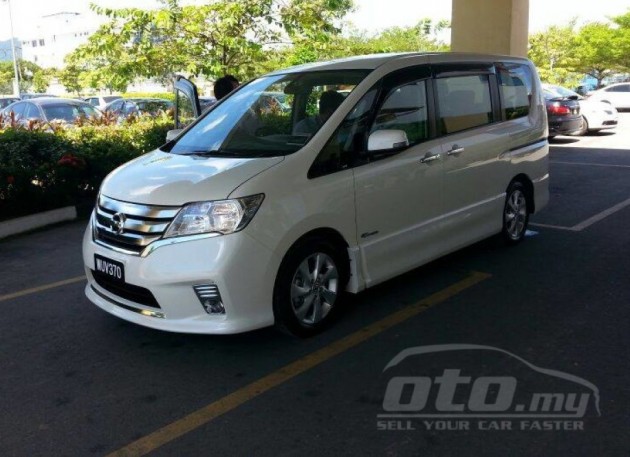Yet another yet to be launched car has popped up for pre-orders on our classifieds site oto.my, and this time it’s a car that we’ve seen prowling Malaysian roads before. It’s the Nissan Serena S-Hybrid, which reader Richard managed to snap near Sungai Besi back in January 2013.
The Nissan Serena S-Hybrid ad on oto.my lists the Nissan Serena S-Hybrid as having a July 2013 launch date, and a tentative price of RM 14x,xxx. Accompanying the ad text are photos of a white Nissan Serena S-Hybrid similiar to the one captured with trade plates earlier, this time with a proper WUY370 plate.
The 2.0 litre engine under the hood is the MR20DD, which is equipped with direct injection and twin valve timing control, mated to an Xtronic CVT gearbox tuned specifically for the new MR20DD. It produces 147 PS at 5,600rpm and 210Nm of torque at 4,400rpm. The Nissan Serena S-Hybrid is actually a ‘micro-hybrid’, essentially a car with a beefed up auto start-stop system. The S in S-Hybrid stands for ‘simple’.
How does the Nissan Serena S-Hybrid micro hybrid system work?
What Nissan did was beef up what it calls the ‘ECO motor’, which is the Serena’s starter motor that allows the car’s auto idle start/stop operation as well as functioning as an alternator during deceleration. The start motor uses a belt pulley type cranking system instead of a normal gear type cranking system. Even the normal Serena has this, but in the Serena S-Hybrid, the capacity of this motor is increased from 1.0kW/150A to 1.8kW/200A, and the engine bay has an extra 12V 27Ah battery for increased storage capacity.
Basically, the bigger starter motor and battery system allows the engine to be freed from having to move the car and power the car’s electrical needs at the same time, resulting in fuel savings. However it’s important to note the ECO-motor does actually contribute to acceleration – this is not a motor assist system like Honda’s IMA.
As a result, fuel efficiency gain is not as drastic as a motor assist (like Honda’s) or full hybrid (like Toyota’s) system. But the impact is enough to justify it’s existence – in Japan, it allows the Serena S-Hybrid to be the only vehicle in its class to be exempted from Japan’s automobile acquisition and weight taxes, because it’s fuel efficiency outperforms the class standards.
Nissan certainly does a good job of making it look the part though – bits that the Serena S-Hybrid gain over the regular Serena include blue headlight inner lenses, high-intensity LED rear combination lights, a clear LED High Mount Stop Lamp and unique graphic icons in the Multi Graphic Upper Meter. These blueish themes are associated with being a hybrid or fuel efficient.
Source: Nissan Serena S-Hybrid ad on oto.my
Looking to sell your car? Sell it with Carro.





















AI-generated Summary ✨
Comments express mixed feelings about the Nissan Serena S-Hybrid, with some criticizing its perceived low value, outdated design, and high maintenance costs, especially regarding gearbox repairs. Others appreciate its competitive pricing, fuel efficiency of 15.2 km/L, and features, hoping for tax rebates similar to hybrids abroad. There is skepticism about whether it qualifies for incentives, given the lack of hybrid-specific benefits in Malaysia. Some comments compare it favorably to other MPVs like the Toyota Innova or Proton Exora, citing size, price, and ride quality, while a few consider it overpriced for what it offers. There’s excitement about its anticipated launch and features such as auto sliding doors, but concerns remain about pricing and build quality. Overall, the sentiments highlight anticipation but also skepticism regarding its value and government incentives.